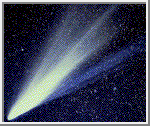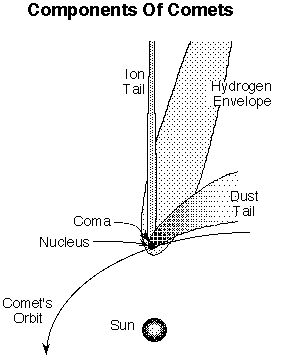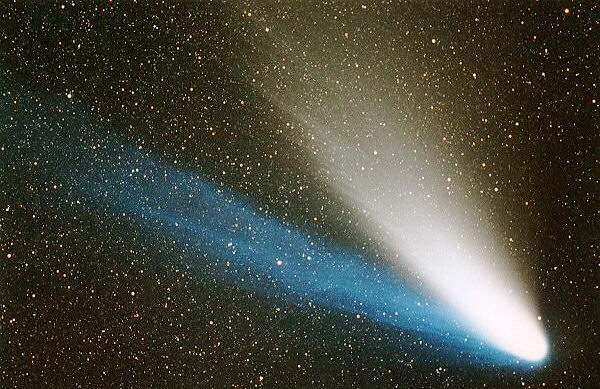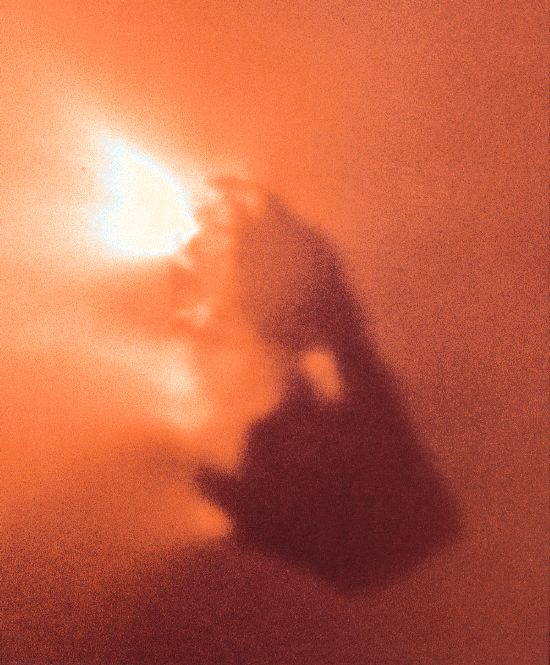We have already looked at a movie of this "orbiting atmosphere" (the yellow donut in the simulation).
Atmospheres in orbit
Before we talk about comets, let's talk about atmospheres some more.
Recall that we noted that all atmospheres are escaping into space, albeit slowly for planets as big or bigger than the Earth.
If the "planet" is really small, any secondary atmosphere that is formed can escape very quickly into space. For example, the escape velocity from the Earth's surface is 11 km/sec, but the escape velocity from the Moon's surface is about 2 km/sec. The escape velocity from Io's surface is about the same, about 2 km/sec. So if the escaping gas is warm enough (has a large enough scale height), it will go right into space in a hyperbolic orbit with respect to Io or the Moon.
Now the Moon has long ago lost any volatiles from its surface, but Io is being cooked to a high temperature in its outer layers, high enough to melt rock! So maybe stuff is being cooked out of Io. What happens to it? Some small fraction will be moving at speeds in excess of 2 km/sec, so it sails off into space from Io. However, it doesn't escape Jupiter!
The escape velocity from Jupiter's surface is about 60 km/sec. The escape velocity from a planet goes as 1/r1/2 , where r is the distance from the center of a planet. So at Io's distance from Jupiter, about 6 Jupiter radii, the escape velocity from Jupiter would be 1/61/2 less than at Jupiter's surface, or about 24 km/sec. Therefore, almost all the material that is cooked out of Io does not escape from Jupiter. It stays in orbit around Jupiter, tending to follow Io's general orbit path. In fact, this cooked-off atmosphere forms a giant donut (torus) around Jupiter.
We have already looked at a movie of this "orbiting
atmosphere" (the yellow donut in the simulation).
Some questions:
Do other solar system bodies have
"orbiting atmospheres"?
Can Jupiter's ring system be thought
of as an "orbiting atmosphere"?
Under what circumstances will an
"orbiting atmosphere" extend only partially along the orbit?
Now let's look at possibilities for cooking "orbiting atmospheres" out of very small bodies in the outer solar system. To understand how this works, we need to look at other frost lines besides that of water:

Phase diagrams of water, methane, and nitrogen superimposed:

So there will be a frost line for each of these substances. Schematically:
If there were methane in the outer layers of a small body, the methane would burst out of the surface somewhere between the water frost line and the nitrogen frost line.
In summary, if the body is big
enough (say as big as Triton or Pluto), it may be able to hold
much of the cooked-off volatiles as a secondary
atmosphere. But if it is very small, say only a few tens
of kilometers in radius, the volatiles are likely to form an
"orbiting atmosphere".
COMETS
A comet can be thought of as a small
body, perhaps a few tens of kilometers in size, with boiled-off
volatiles as a secondary atmosphere. Because the body
cannot hold these gases, the volatiles form an "orbiting
atmosphere". Where the atmosphere forms and what it is
made of, is determined by where the comet is with respect to a
frost line.


Humans have
known about comets since ancient times. Ancient astronomers in
China, Babylon, Egypt, and Greece wrote down their observations of
them.
Because comets
were unpredictable, spectacular, and relatively brief celestial
events, they were often feared as evil omens. Some people
thought that comets foreshadowed great events. The appearance of
Halley's Comet in the year 1066 is commemorated in the ancient Bayeaux
Tapestry. Later that same year, William the
Conqueror invaded England and established the British monarchy
that still exists today. The appearance of Halley's Comet in
late 1835 was followed a few months later by the successful
rebellion of the Mexican state of Texas.
On some comets, the ion tail and the dust tail are not easily distinguishable. On the other hand, Comet Hale-Bopp, which appeared in 1997, showed off its two tails beautifully. The ion tail is the blue one, the color coming from fluorescence of the ionized gases.


In the past two decades, several spacecraft have had rendezvous with the nucleus of an active comet. This has provided the first pictures of coma formation. It turns out that the vaporization of gases is not spread evenly over the surface. Rather, it is concentrated in a few "jets." Most of the surface is extremely dark, reflecting only 3% of the light that shines on it. The dark surface is made up of rocky dust that is left behind when the ices vaporize, while the jets are areas where vaporizing gases have broken through this dark crust.
This picture is of the nucleus of Halley's Comet, The nucleus is only 16 km across, and the few bright jets are prominently visible. The image was taken by Giotto, a European spacecraft that encountered the comet in 1986.

and here
is a picture of the nucleus of Comet
Tempel 1, taken by the NASA Deep
Impact spacecraft just before it launched a
projectile at the nucleus. Icy patches are color-enhanced
to blue. The Deep Impact projectile impacted the comet on
July 4, 2005:

And finally, here is a movie (Quicktime format) of the November 4 encounter of the Deep Impact spacecraft with Comet Hartley 2.
Incidentally, some short-period comets are on orbits that cross the orbit of Earth. Debris from these comets periodically enters the Earth's atmosphere, causing the phenomenon of meteors. The Leonid meteor shower, which occurs in November, is caused by debris from Comet Tempel-Tuttle. Most meteors are no bigger than a grain of sand, but their high velocity causes them to flash brightly as they burn up in the atmosphere.